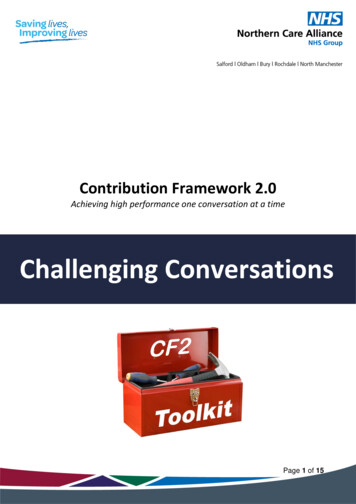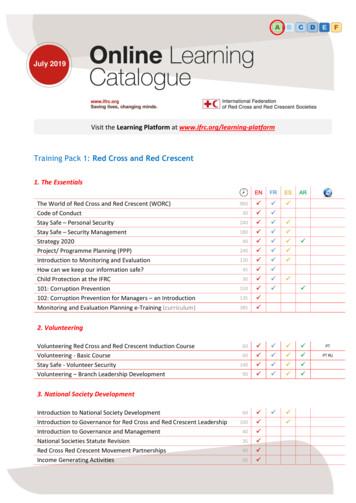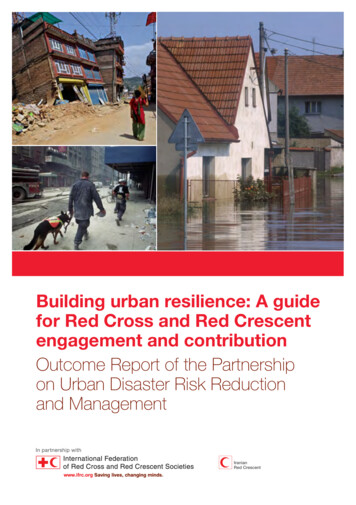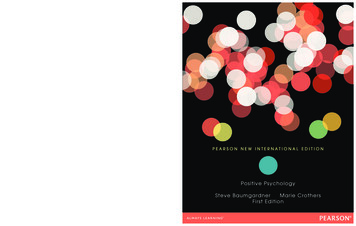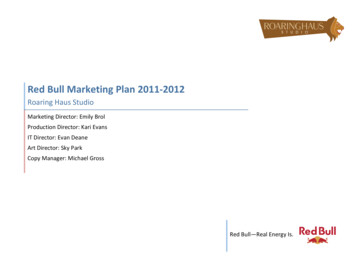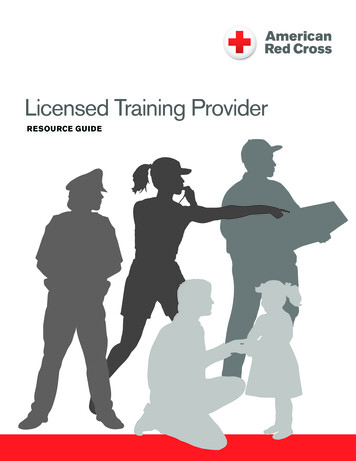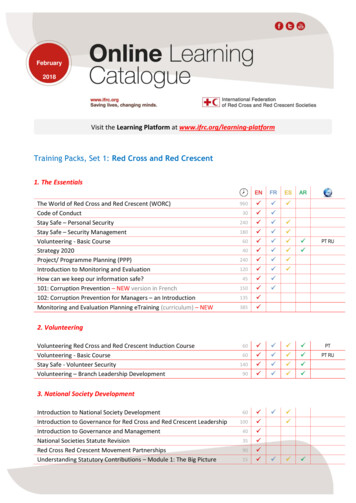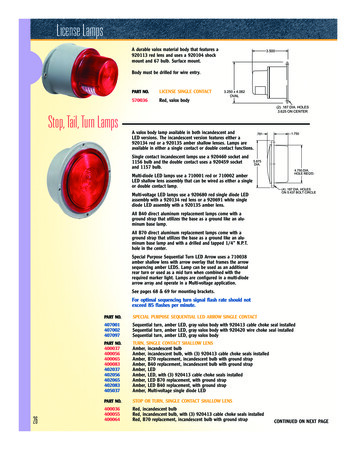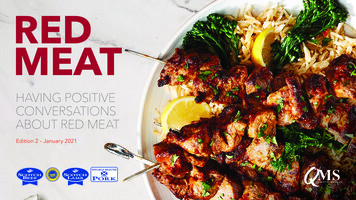
Transcription
HAVING POSITIVECONVERSATIONSABOUT RED MEATEdition 2 – January 2021
OverviewQuality Meat Scotland (QMS) has collated this pack of materials to helppositively manage the reputation of red meat during January 2021and beyond.It includes a number of assets and materials that can be used throughoutJanuary, forming a common narrative for the Scottish red meat industry.QMS strategyVeganuary and Brexit are upon us. This year the strategy is not to defend ourindustry, it is to promote the benefits of our industry, be bold and be proudof what we do. Our campaign will focus on three key areas, Local, The Scotchdifference and Health and wellbeing with a particular focus on Vit B12 and itsbenefits. VitB12 is responsible for many bodily functions and may benefit yourhealth in various ways, such as boosting your energy, supporting bone health,improving mood and maintaining healthy skin and hair.Contents3.4.5.6.7.8.9.10.11.13.15.18.Results from Veganuary 2020Market Context – UKMarket Context - ScotlandBackground on Veganuary & The Media Landscape for 2021Summary of Planned QMS ActivityGet Involved – Social MediaGet Involved – Meat & Nutritional FactsGet Involved – Sustainability FactsGet Involved – Recipe InspirationQ&A Support – Health & NutritionQ&A Support – Environment & SustainabilityUseful Links2
Results from Veganuary 2020Based on a February 2020 Worldpanel Plus LinkQ surveyof 56,117 responses:70%9%70% gave up within twoweeks and only 18%successfully completed thewhole monthWhilst over 2/3 of respondentswere aware of Veganuary, only9% actually participated in theevent itselfDriversResultParticipation was drivenprimarily by health reasons,though not far behind wereenvironmental, ethical,personal and financial driversOnce Veganuary was over,participants were more inclinedto reduce or swap foods asopposed to adopting a strictlyvegan or vegetarian diet3
ARKEONTEXUK80%2/3rd70%of British householdsdo not contain any meatavoiders (vegetarians/vegans)Whilst over 2/3 ofrespondents were awareof Veganuary, only 9%actually participatedin the event itself – aconversion of just 14%Those who take part havethe intention, but notthe commitment – 70%of participants gave upwithin 2 weeksSource: Panel of 56,117 GBhouseholds (5000 for those whotook part in Veganuary)Source: Panel of 56,117 GBhouseholds (5000 for those whotook part in Veganuary)Source: Kantar4
ARKEONTEXScotland67%70%67%of respondents aremore aware oftrying to buy localfood and drinkof respondents aremore aware nowadaysof the role of red meatin a healthy dietof respondents aremore aware of theenvironmental impact oftheir grocery shoppingchoicesKey drivers steering beef and lamb preference andpurchase are taste and texture, menu versatility, andbeing a rich source of healthy protein and iron.Source of figures - MRQual Research Agency & kwad consulting,QMS Research, Attitudes to Scotch beef and lamb, July 20205
Background on VeganuaryLaunched in the UK in January 2014, Veganuary encouragespeople to try going vegan for January (and beyond).Since the campaign started, more than 500,000 people haveregistered to try veganism. It mainly uses endorsements fromcelebrity actors and TV personalities, politicians and chefs togain media attention and recognition for its cause. The campaignin the past has been highly active across social media.The Media Landscape for 2021QMS and its rostered agencies constantly horizon scanfor TV shows, documentaries and press features that mayhave an anti-red meat agenda.As of this pack being issued, there are no knownprogrammes on the agenda for January but please docontact info@qmscotland.co.uk if you hear or see anythingthat requires our attention.6
Summary of Planned QMS ActivityThere are a number of proactive activities alreadyplanned throughout January to support the reputationof Scottish red meat:60 seconds/30 secondsadverts on al mediapostsWeb trafficdrive to ScotchKitchen websiteMedia partnership7
ET INVOLVESocial MediaWe’ve recommended some key individuals to follow. This way you can easilyshare and retweet any content and key messages across all social channels.We would only recommend responding to conversations where we havesufficient research and evidence to make an informed contribution. A persuasive,comprehensive and evidence-based answer will limit any risk of further criticism.Follow these Social Media Influencers and share their contentFrédéric Leroy, Professor of Food Science@fleroy1974Follow QMS and share our contentthroughout January (and beyond)Joanna Blythman, Investigative journalist and FoodWriter of the Year ank M. Mitloehner, Animal science@GHGGuru@qmscotland@ScotchKitchenKate Rowell, Chair of Quality Meat otlandfacebook.com/scotchkitchen8
Meat & Nutritional FactsThe key message is balance. Different food groups work bestwhen consumed together in moderation as part of a balancedplate approach. Beef, pork and lamb can play an important rolein a healthy, balanced diet.Red meat is naturally richin protein, low in salt andprovides a range of vitaminsand minerals that contributeto good health, includingiron, potassium, zinc, vitaminB12 and niacinA red meat diet providesvitamin B12Red meat is low in salt(sodium), reducingconsumption of sodiumsupports normalblood pressureOur bodies absorb iron andzinc from meat more readilythan from plantsZinc helps withfertility andreproductiondGet involvofeinfographics andbankrole ofQMS has aunicate themmochicdiet.videos wh, balancedyhltaeham andred meat inok, InstagraobecaFruVisit oare.nnels to shahcrteitwTd in ouran be founctsessalad.All sociato downloREDLOFDROPBOXProtein helps themaintenance of normalbones and growth inmuscle massVit B12 is not naturallypresent in a vegan dietPotassium contributes tonormal muscle and nervefunction and helps supportnormal blood pressure
Sustainability FactsScotland is oneof the mostsustainable placesin the world toproduce beefand lamb. Due toour weather andtopography itrequires very fewinputs to producenutrient dense,high quality food.68%Transport, industryand power accountfor approx. 68% ofUK greenhouse gasemissions. Livestockfarming accounts foraround 5%35%UK beef and lamb carbonemissions are 35% lowerthan the current globalaverage, FAO 2016Red meat fromScotland and Britainis amongst the mostsustainable in the worldCurrently, not allmitigating factors aretaken into account whenassessing the impactof livestock productionon the environment,painting livestockin an unfairnegative lightFrom 1990 - 2017, Scottishagriculture decreased itsGreenhouse Gas (GHG)emissions by 29% and iscontinuing to work hard topioneer new technologieswhich will potentiallydecrease methaneemissions and increasecarbon capture in theextensive grass areas ofScotlandOver 80%of Scottish agriculturalland is grassland,less suitableeconomically andenvironmentally foranything other thanlivestock grazing90%Over 90% of beef andsheep feed is grass,silage and brewersgrain meaning theindustry is not drivingglobal soya productionThese grasslandscapture and storecarbon from theatmosphere, provide ahabitat for wildlife andaid biodiversityDifferent methodologiesare used to calculatecarbon equivalents,meaning it is difficult tomake fair comparisonsacross food types andindustries
RECIPE INSPIRATIONScotch BeefScotch LambFuel-up for the gym with these nutritious Scotch Beef recipes.Not only are they delicious and packed with protein, but theyalso contain a range of essential vitamins and minerals whichcontribute to a healthy, balanced diet.We love these Scotch Lamb recipes by @scotchkitchen. They'reprotein-rich and high in Vitamin B12, which helps to reducefatigue. It can help support your immune system too!CURRY NIGHTLocally sourcedScotch Beef PGILOW IN FATOnly 11g of fatper servingTO SHARELOCAL TONIGHTHigh in Protein43g per servingLocallysourcedScotch Lamb PGILocally sourcedScotch Beef PGIHigh in Vitamin B12which helps reducetiredness and fatigueScotch Beef RendangPerfect for the slow cookerscotchkitchen.comFind out where to buy Scotch Beef PGI at scotchkitchen.comView recipeHigh in Vitamin B12which helps reducetiredness and fatigueHigh in Vitamin B12which helps reducetiredness and fatigueScotch Beef PhoCooked in under one hourscotchkitchen.comFind out where to buy Scotch Beef PGI at scotchkitchen.comView recipeScotch Lamb Tacos withBaba Ghanoush & PomegranateCooked in just 30 minutesscotchkitchen.comFind out where to buy Scotch Lamb PGI at scotchkitchen.comView recipeStuffed Half Leg of Scotch Lambwith Kale & Butternut SquashPerfect for a Sunday roastscotchkitchen.comFind out where to buy Scotch Lamb PGI at scotchkitchen.comView recipe11
RECIPE INSPIRATIONSpecially Selected PorkLooking for a quick and easy meal guaranteed to satisfy eventhe fussiest of midweek diners? These dishes certainly fit the billand serve up a balanced meal packed full of flavour.HIGH IN PROTEIN41g of proteinper servingLocally sourcedSpecially SelectedPorkBlackenedSpecially Selected PorkCooked in just 40 minutesscotchkitchen.comFind out where to buy Specially Selected Pork at scotchkitchen.comView recipe12
Health & NutritionQ: What are your views on veganism as a diet?Choosing to exclude all animal products is a personalchoice – it is not vital for good health. The majority ofpeople in the UK include animal products like red meatand dairy, and these can be part of a healthy, balanceddiet. We get a significant proportion of nutrients like ironand zinc from meat and meat products and we needmore research on the long-term effects of a vegan dieton health in larger population groups. It’s important thatthose considering a vegan diet make sure it’s varied andbalanced to ensure it provides all the nutrients needed,and to consider supplements and/or fortified foodsto provide vitamin B12, which is generally only foundnaturally in animal foods. When looking at vegan orplant-based products it shouldn’t be assumed that theyare automatically a healthy choice – it’s still important tocheck the label and avoid having those that are high insaturates, salt or added sugars too often.Q: Is switching towards a more plant-based diethealthier for you?Well-balanced plant based diets can provide thenutrients the body needs to be healthy. There is someevidence that dietary patterns that include plenty ofplant-based foods (but don’t necessarily exclude meat/animal foods) have health benefits. A more plantbased diet is typically higher in fruit and vegetables,wholegrains and dietary fibre while being lower insaturated fat and added sugars. The evidence specificallyfor vegan diets and health is limited, although someevidence suggests a reduced risk of some diseases,such as cancer. However, nutrition experts will agreethat people who follow more plant-based diets are oftenmore health conscious overall and also adopt otherhealthier lifestyle factors. For instance, they are morelikely to be physically active, have healthier weights,consume less alcohol, are less likely to smoke, as wellas being more likely to have a higher income. This mayexplain some of the observed health benefits. In addition,not all plant-based diets are equal! Well-plannedvegetarian and vegan diets can be nutritious and healthy,but it is also possible to follow a vegan diet badly. Foodsthat are suitable for vegans can also be high in saturatedfat, salt and added sugars, such as deep fried foods,biscuits, crisps and confectionery.13
Health & NutritionQ: Is red meat unhealthy for you as it is high in fat?Red meat is a source of protein, iron, vitamin B12, andzinc making it a nutritious food. Nowadays, the fat andsaturated fat content of some lean cuts of red meat is lowerthan we may think. UK composition data shows that theaverage fat content of lean lamb is 8% while lean beef is 5%and lean pork can be less than 3%.Q: Is red meat only important for you to help with youriron intake?Red meat is one of the best sources of iron as our bodiescan easily absorb it. Iron supports the formation of redblood cells, normal immune function and contributes tonormal cognitive function. Currently a quarter of femalesaged 19 to 64 years in the UK have average iron intakesbelow what is adequate for most people. Red meat alsocontains many other important nutrients for optimal health,including protein, zinc, B vitamins including vitamin B12,selenium and also contributes somevitamin D.Q: Would switching to a Flexitarian diet be betterfor the environment?A flexitarian or semi-vegetarian diet (SVD) is one that isprimarily vegetarian with the occasional inclusion of meator fish. It has also been argued that as well as meat/animalprotein there are other environmental polluters, such asfossil fuels, industry and transport. In fact, while emissionsof the entire agricultural sector (including livestock andaquaculture) account for 10% of the total, those due to theuse of fossil fuels represent a far more important 64%.Q: Is red meat linked with cancers and other healthissues?It’s fair to say red meat has been disproportionatelydemonised by the reports like EAT Lancet and IARC.However, the claims they make about the dangers ofred meat are not as scientifically robust as media oftensuggest. No one food group causes cancer and the studiesreporting findings are based on observational studies, notcause-and-effect experiments.When it comes to lean red meat, there is no evidenceshowing any causal relationship with the initiation ofcancers. Avoiding red meat in the diet is not a protectivestrategy against cancer, as results from many studiesshow an extremely weak association between high redmeat consumption and increased cancer risk. Thereis also evidence from large European studies whichillustrate that the risk of bowel and colorectal cancer isthe same, whether you eat meat or follow a vegetariandiet. Additional research has demonstrated no associationbetween red meat intake and risk of other types of cancerincluding prostate and breast cancer.14
Environment & SustainabilityQ: What about the environmental impact of food groupsinvolving livestock farming?Ruminants are the only species able to transform marginalgrasslands, which have few alternative uses, into food for thepopulation. At a time when the population is increasing sodramatically, it is essential that livestock rearing continues,to ensure that land can be used effectively for growingcrops and global food security is maintained. Animals alsoplay a vital role in growing crops effectively and sustainably,as manure enriches the soil with nutrients to help themgrow. Without livestock we would increase our relianceon chemical fertilisers, which are produced by usingnonrenewable energy therefore, further contributing toour carbon footprint. Responsible and strategic livestockfarming is a highly productive industry which produces alarge amount of food for the population. When carried outeffectively, carbon emissions can be minimised, with meatproduction playing an important role in global food security.Q: Isn’t livestock farming one of the most significantcontributions to carbon emissions?In livestock farming, the three gases that are emitted intothe atmosphere by farming activities are carbon dioxide,methane and nitrous oxide. These gases vary in potencyand in the length of time they last in the atmosphere. Forexample, methane is around 28 times more potent than CO2but only lasts for around 12 years whereas CO2 lasts for upto 200 years. Biogenic methane (that comes from cattle) is aflow gas which can be recycled - hence it's lower lifetime inthe atmosphere. Some scientists think that the way biogenicmethane emissions are calculated should be reconsidered.It has also been argued that as well as livestock thereare other environmental polluters, such as fossil fuels,industry and transport. In fact, while emissions of the entireagricultural sector (including livestock and aquaculture)account for 10% of the total, those due to the use offossil fuels represent a far more important 64%. It is alsoimportant to make the distinction that carbon emissionsfrom livestock farming vary across the globe and the UK is,in fact, a relatively sustainable place to produce meat.Q: Will reducing the UK’s red meat consumption notsignificantly improve our environmental impact?Suggesting that people should stop or cut down on theamount of red meat they consume is not the answer toimproving the UK’s environmental impact and reducingcarbon emissions. Arable and livestock farming areintrinsically linked. Animals play a vital role in growingcrops effectively and sustainably, because animal manureis needed to enrich the soil with nutrients in order to helpthem grow. Without livestock, we would increase ourreliance on chemical fertilisers, which are produced byusing non-renewable energy therefore, further contributingto our carbon footprint. 60% of the UK’s agriculture landis marginal grassland, unsuitable for little else other thanlivestock grazing.15
Environment & Sustainabilityto the UN Food and Agriculture Organisation. It also helps toreturn nutrients to the soil, known as nutrient recycling.Q: Can you explain in more detail how livestock farmingcan have a positive impact on the environment?Sustainable food source - Only ruminants are able to transformgrass and forage land into food for us, such as dairy and meat,and there is a large amount of marginal grassland which can’tbe used for anything other than livestock grazing. From Walesto the Scottish Highlands, there are many upland areas in Britainunsuitable for growing crops but perfect for allowing livestockto graze. The soil will be able to hold huge amounts of waterand provide flood protection for lower lying areas. And, whenthe farmers are making a living by selling milk and meat fromtheir grass-fed animals, there is a perfect cycle of sustainability:good for the soil, good for the environment, cattle with a goodlife, producing healthy food for us.Carbon Sequestration - The soil is alive with micro-organismsand when plants take carbon from the air, as well as for theirown growth, they use it in a symbiotic relationship to feed thesoil microbes in exchange for nutrients and other ecologicalfunctions. Plants do this by releasing exudates via their roots inthe form of many different carbon compounds. Organic matterfrom the biomass of plant roots as they grow and die, plantmatter trodden into the soil by grazing cows, along with themanure they leave behind, all adds carbon (and other nutrients),which the microbes ultimately convert into complex and verystable carbon compounds called humus. Each time a cow takesa bite of grass it triggers the plant to release exudates in orderto receive in return the nutrients needed for rapid regrowth. Thegrass’s rate of photosynthesis goes up, more grass (biomass) isgrown and more carbon is removed from the air and pusheddown into the soil. The action of grazing repeatedly pushes thegrass back into its growth stage and as long as grass is activelygrowing, carbon is being removed from the atmosphere andsequestered into the ground.Preventing topsoil depletion - In the UK, topsoil depletionis so severe that in 2014 the trade magazine Farmers Weeklyannounced we may have only 100 harvests left. Letting arableland lie fallow and returning it to grazed pasture for a period – asfarmers used to, before artificial fertilisers and mechanisationmade continuous cropping possible – is the only way to reversethat process, halting erosion and rebuilding soil, accordingFlood protection – When managed effectively, marginalgrasslands can act as the perfect sink for water, providing floodprotection for lower lying areas. These sinks can also feed intothe water supply, helping to supply water for consumption tolarge city populations.Biodiversity – Livestock grazing is crucial to encouraging andmaintaining biodiversity. Without maintaining a low level ofgrazing across grasslands, species-rich grasslands are replacedby taller, wild grasslands with lower species diversity. This wasdemonstrated when agricultural subsidies transitioned to areapayments, leaving much grassland unmanaged, and resulting ina sharp decrease in biodiversity.Social and economic benefit to rural communities – Livestockfarming can provide vital social and economic benefits to ruralcommunities, such as food supply, source of income, source ofemployment etc.16
Environment & SustainabilityQ: What are livestock farmers doing to becomemore sustainable?Steps farmers are taking to be more sustainable include: Taking action to control soil erosion Protecting peatland and moorland from damage byavoiding ploughing, drainage and over grazing Considering reduced cultivation to protect farm soilsand reduce carbon losses Managing existing farm woodlands and consideringnew planting Creating wildlife corridors along water margins, fieldmargins and headlands Protecting and where necessary restoring wetlandsincluding floodplain management Planting trees and wild flowers Ensuring farms are run efficiently - generally, a moreefficient farm is a more sustainable farm Many Scottish livestock farmers conduct regularcarbon audits to measure their carbon outputs toallow them to identify how they can work to reducetheir farm's carbon footprint17
USEFULLINKS1. on/NHS Live Well site – gives balanced view and is viewed as reliable source.2. on-deficiency.htmlBritish Dietetic Association Iron fact sheet – red meat as best sources.3. nutrition/nutritionalcomposition-of-meatScience text book – but has all the info on nutritional composition of meat.4. https://www.researchgate.net/publication/286373369 The role of red meatin the diet nutrition and health benefitsThe role of red meat in the diet: nutrition and health benefits by Laura Wyness.5. s/22/Farming Foodsteps Lesson To Health – Red meat as part of a healthy balanced diet.18
Contact DetailsLesley CameronQMS Director of Marketing& CommunicationsT 0131 510 8476M 07774 926 846E lcameron@qmscotland.co.uk
Fin u her u cotc am GI t scotchkitchen.com Scotch Beef ho Cooke er oe hor Locall ource Scotc ee GI LO I FAT per erving scotchkitchen.com Fin u her u cotc ee GI t scotchkitchen.com Stffed af eg of Scotch a th ae Bttent Sah Perfect for rost Hig rotein 43 e erving Hig itami 12 whic elp educ tiredness nd atigue scotchitchencom
